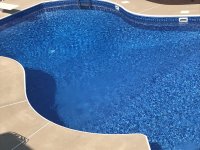I had a little bit of haze and after testing the pool store suggested I add Hardness Plus, which I did, and it seemed to have done the trick. From what I've read, seems like adding Calcium wouldn't do that, but why did it seem to work?
This was my first visit to Leslies as my local shop was closed for the weekend.
Any ideas why would the test results vary so much from shop to Leslies? Whatever my shop does, they DON'T use the device that has the cuvettes in a carousel, but looks like drops added from a test kit of some type. These test were done a day apart.
Local shop numbers
alk 90
ph7.4
free and total chl 3.0
stabilizer 90
Salt 3300
hardness not normally checked, but two months ago was ~200
Leslies:
alk 65
ph 7.4
free and total chl 3.3
stabilizer 51
salt 2868
hardness 68
Phos 156 (is this high and need to be brought down?)
Is the methodology that different? I do trust the local shop as the water has been great for the 3 years they've been helping me, and they never push for more chemicals. Normally just a few bags of salt for the season. I'm not very experienced with the chemistry side since it's been pretty hands off for the last three years I've lived here. New liner this spring, so had to start new with city water.
Thanks for any suggestions.
Picture for reference. Pump on and a breeze, but looks pretty good to me.

This was my first visit to Leslies as my local shop was closed for the weekend.
Any ideas why would the test results vary so much from shop to Leslies? Whatever my shop does, they DON'T use the device that has the cuvettes in a carousel, but looks like drops added from a test kit of some type. These test were done a day apart.
Local shop numbers
alk 90
ph7.4
free and total chl 3.0
stabilizer 90
Salt 3300
hardness not normally checked, but two months ago was ~200
Leslies:
alk 65
ph 7.4
free and total chl 3.3
stabilizer 51
salt 2868
hardness 68
Phos 156 (is this high and need to be brought down?)
Is the methodology that different? I do trust the local shop as the water has been great for the 3 years they've been helping me, and they never push for more chemicals. Normally just a few bags of salt for the season. I'm not very experienced with the chemistry side since it's been pretty hands off for the last three years I've lived here. New liner this spring, so had to start new with city water.
Thanks for any suggestions.
Picture for reference. Pump on and a breeze, but looks pretty good to me.

Last edited:


